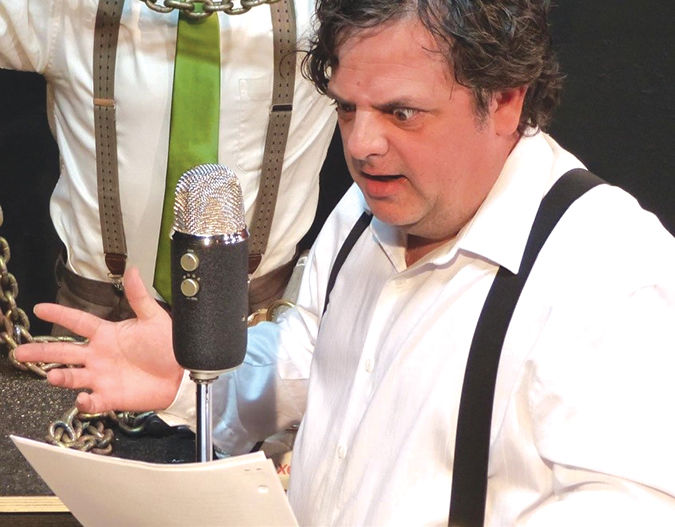The night is black. A furtive stranger lurks within the shadows while flickering gas lamps barely pierce the pea soup fog enshrouding Queen Victoria’s London. The hollow clatter of a horse’s hooves sounds upon the cobblestones as a hansom cab brings an anxious client to 221B Baker Street.
Remember the exquisite thrill you enjoyed the first time you read a Sherlock Holmes adventure?
The same exhilaration embraced radio audiences in 1939 upon first listening to Basil Rathbone as the Great Detective. Crackling with brisk determination, his incisive voice was a perfect counterpoint to that of his great friend, Nigel Bruce, whose avuncular Dr. Watson on the air was much less bumbling than in the popular series of motion pictures the two starred in.
By a happy instance, this weekend and next, audiences can sample richly imaginative radio drama in the Long Beach Shakespeare Company’s production of “Sherlock Holmes in the Valley of Fear,” presented live on stage as a radio show that will be simultaneously webcast over the Internet. “The Valley of Fear” was first published in February 1915 by the George H. Doran Company in New York. Demonstrating the novel’s enduring popularity, in July 2010, Sotheby’s auctioned a copy signed by Sir Arthur Conan Doyle which fetched a sum of $784,000.
Although first appearing in two novels, “A Study in Scarlet” and “The Sign of Four,” the phenomenal success of Sherlock Holmes did not strike until after the character starred in a series of 56 short stories beginning in 1891 in England’s Strand Magazine. The producers have made a superb choice for their show by selecting the last Holmes novel, “The Valley of Fear,” which displays Sherlock Holmes at his analytical best.
“In many cases Holmes’ deductions are used more for window dressing to impress his clients, while the rest of the story is an adventure with Holmes chasing down the criminal,” says writ-er/director Helen Borgers. “In ‘The Valley of Fear,’ the murder occurs in a castle surrounded by a moat. The killer gets away despite the drawbridge being up. The victim’s wedding ring is missing. The audience is asked to question the significance of a missing dumb-bell and a calling card left at the scene of the crime bearing the message, ‘VV341.’
“Holmes’ deductions have a decisive bearing on the solution of ‘The Valley of Fear,’” Borgers added. “The clues lead to Pennsylvania and a group called the Scowrers, based on the Molly Maguires, a secret society whose members were accused of murder, arson and kidnapping by members of the Pinkerton Detective Agency. And behind all the skullduggery is the shadowy figure of Professor Moriarty.”
Having set the stage with a brilliant mystery, director Borgers has selected the troupe’s Mike Austin to read the part of Holmes, while members of the cast will be handling the live sound effects so necessary for effective radio dramas. Musical bridges will be used as needed, taking care not to neglect ominous stings from an organ to heighten the mood.
“The Valley of Fear” is quite apropos to this time of year. Each January the Baker Street Irregulars of New York, founded in 1934, named for the ragtag gaggle of street urchins Holmes occasionally employed “to go everywhere, see everything, and overhear everyone,” hosts celebrations to honor the birth of the Sage of Baker Street. Jan. 6, the Feast of the Epiphany — also known as Twelfth Night — was chosen as the birthdate of Sherlock Holmes by Christopher Morley, the famed writer, novelist, editor and columnist who founded the BSI.
Morley decided the date because among all the Shakespearean allusions Holmes makes, he quotes most from “Twelfth Night.” Some years later, William S. Baring-Gould, the highly-regarded scholar who wrote “Sherlock Holmes of Baker Street: a Biography” (1962) and edited the magisterial “Annotated Sherlock Holmes” (1966), found another reason for the date.
As “The Valley of Fear” opens on Jan. 7, 1888, readers find Holmes in a querulous mood, even snapping at Watson.
By way of a convenient, tongue-in-cheek syllogism, Baring-Gould asks why Holmes would be in such a bad mood? Answer: Very likely due to a hangover. Why would Holmes have a hangover? Answer: He must have been celebrating the night before. What had he been celebrating? Answer: Most obviously, his birthday.
Dare I say, “It’s elementary”?
‘Sherlock Holmes and the Valley of Fear’
The Long Beach Shakespeare Company presents “Sherlock Holmes and the Valley of Fear” at the Richard Goad Theatre, 4250 Atlantic Ave, Long Beach. Showtimes are Fridays and Saturdays at 8 p.m., Sundays at 2 p.m., Jan. 16-25. All tickets are $10 and available at www.lbshakespeare.org or by calling (562) 997-1494.

